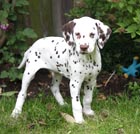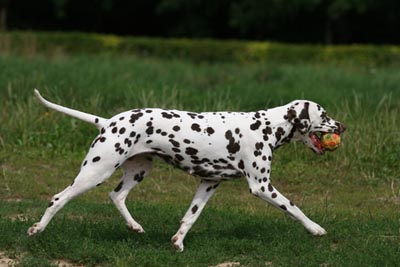Dotty about dalmatians
Country Life talks to damatian owners, to find out what makes this distinctive dog breed tick


Dozens of celebrity couples stepped out in 1950s London, but one pairing in particular captured the nation's imagination. Always the height of style in their matching black-and-white ensembles, the smart twosome could often be found walking side by side around Regent's Park, where passers-by would pause to admire their splendidly shaped heads, fine shoulders-and ramrod-straight tails.
Pongo and Missis, stars of Dodie Smith's 1956 children's classic The Hundred and One Dalmatians, outclass their owners-the rather homely Dearlys-at every turn. Missis, Smith writes, ‘had a most winning expression' and Pongo ‘though a dog born to command, had a twinkle in his eye'. Contrast this with poor old Mr Dearly, for whom the most that can be said is that he had ‘the kind of face you don't get tired of'.
Smith's novel confirmed what dalmatian owners have always known-that these distinguished and dashing dogs make superb companions. But their subsequent Disneyfication in 1961 (which saw Perdita taking Missis's place at Pongo's side) did the breed a disservice. ‘A lot of children who persuade their parents to get them a dalmatian soon discover that they're lovely as pups, but hard work at six months. They're very full on, and they carry on like that until they're about 18 months old,' says Anne Gurnsey of British Dalmatian Welfare (www.dalmatianwelfare.co.uk).
The charity rehomes between 100 and 120 dogs each year and saw a sharp increase in the number being brought in after the 1996 remake of 101 Dalmatians-which starred Glenn Close as Cruella de Vil-was released. ‘People hadn't done their homework and couldn't provide an appropriate home for them. They're a very rewarding breed and extremely responsive, but hard work to train. Some dogs love to perform certain tasks over and over again, but a dalmatian is likely to say "I know this trick, and I'm not going to do it a second time". They also shed a lot of white hair everywhere.'
Dalmatians were never meant to be fashion accessories-their hunting instinct is true and, in centuries gone by, they excelled in the field as trail hounds and retrievers and as part of a pack. One atmospheric painting by the Dutch artist Jan Fyt (1611-61) shows a hunting scene peopled by various breeds, including greyhounds and spaniels, but the dog in the foreground is unmistakably a dalmatian.
These are endurance dogs and their efficient trot enables them to romp along for hours without tiring. In centuries gone by, they ran alongside carriages to protect their occupants by day and caught rats in the stables by night. Not for them a quick walk round the block and a snooze by the fire afterwards-they require vigorous exercise, and lots of it, plus mental stimulation to keep their busy brains ticking over. ‘They're such energetic dogs and require so much exercise that they're more suited to a rural lifestyle,' explains the Kennel Club's (KC) David Robson. Anne Dickens of the British Carriage Dog Society (http://carriagedog.org), set up eight years ago to promote the animals' capabilities, agrees: ‘They've always had a strong affinity with horses and have amazing endurance capabilities.'
She's quick to dismiss the charges of jumpiness and unpredictability that are sometimes levelled at the dogs-a misconception that may have contributed to KC puppy registrations falling from 2,253 in 2003 to 1,163 in 2013. ‘Like most breeds, they only become neurotic if they're bored and underoccupied.' Her two dalmatians, Munin and Fenris, have shone at the society's competitions, in which canine entrants must work beside both driven and ridden horses. ‘They really get into a groove alongside a carriage.'
Sign up for the Country Life Newsletter
Exquisite houses, the beauty of Nature, and how to get the most from your life, straight to your inbox.

Pete and Colette Finch, newcomers to the carriage-dog world, discovered this when they rehomed two-year-old Romeo last year. The newest member of the family proved to be full of surprises. ‘He'd lived in a terraced house on a busy main road-the only things he'd seen with wheels were cars and a pushchair,' Mrs Finch explains. ‘But the day after we got him, Pete took him out with the pony he was breaking to harness. Romeo knew exactly what to do, like a collie knows how to round up sheep. It was pure instinct. He's now done a complete season of driving rallies.'
Dalmatians are also at home in the racing world. Jump jockey Richard Johnston is an admirer and Newmarket trainer's wife Emma Berry gave her husband, John, one for his birthday three years ago. ‘Gus was the best present you could ever have,' he enthuses. ‘He's a terrific dog with a lovely mixture of energy and docility-affectionate, sweet-natured and loyal.' Gus likes nothing more than accompanying his master to the races. ‘He hates vehicles leaving without him and will sit in the horsebox to make sure he doesn't get left behind.'
Gus was bred by Thea Gosden, daughter of leading Flat trainer John Gosden. ‘When she was 16 and unable to go to school for a year due to a chronic-fatigue condition, she somehow persuaded her father to let her have a dalmatian. They returned from what was meant to be a reconnoitre with a puppy, Venus, who has proved a complete joy,' explains Thea's mother, Rachel Hood. ‘During her gap year, she decided to devote some time to breeding from Venus and the result was 11 puppies, one of whom is the Berrys' beloved Gus. Thea kept Violet from the litter and was besieged by potential buyers, all of whom she vetted with the zeal of a mother.'
Paul Gismondi, a managing dir-ector at Lazard Brothers & Co, who's had dalmatians for decades, is ano-ther hopeless devotee. He has Rita, a liver-and-white seven year old, who shares her Norfolk home with a German pointer, a basset hound and a black labrador. ‘They're much maligned,' he insists. ‘People think they're a little bit crazy, but Rita is very biddable and will even retrieve-not perfectly, but reasonably well. And they smile at you, which is particularly endearing.'
Dalmatians, it's clear, have a sense of occasion. Combined with their boundless energy and striking good looks, this makes them a natural fit for the circus. Nell Gifford, who owns and runs Giffords Circus (www.giffordscircus.com), has two dalmatians, Tarquin and the aptly named Domino. Both came from owners who were no longer able to look after them. ‘I'd urge anyone seriously interested in taking on a dalmatian to think about rehoming one rather than buying a puppy,' she says. ‘There are so many lovely, unwanted dogs out there.'
Mrs Gifford has big plans for the troupe's newest members. ‘We already owned spotted horses and thought it would be fun to develop an act combining them with spotted dogs,' she remembers. ‘When Tarquin and Domino arrived, they were like overgrown puppies, with next to no training. But we immediately started exercising them as if they were young hounds, getting them to follow bicycles. They're such fun dogs-really jolly and upbeat, even if not naturally the most obedient.'
Tarquin and Domino's act will form part of this year's Giffords Circus show. They'll be joined by two smaller performers-Mrs Gifford recently acquired two spotty terrier crosses from a dogs' home in Birmingham. ‘They'll be the counter-point-the clowns to the elegant dalmatians,' she explains excitedly. Just don't mention fur coats.
Did you know?
* Dalmatians are also referred to as English coach dogs, carriage dogs and plum-pudding dogs * Debate continues about the origins of the breed and its name. Spotted dogs appear in Egyptian bas-reliefs and Greek friezes and a dog known as the Bengal pointer, similar in looks, was found in England in the 1700s. This calls into question the dog's supposedly Slavic origins * Dalmatians were once fire-fighters' best friends-they escorted their wagons and would run in front of them to clear a path through traffic * Dalmatian puppies are born pure white-they develop their characteristic black, lemon, orange, blue or liver-hued spots a few weeks later * In the original 101 Dalmatians movie, Pongo has 72 spots, Perdita has 68 and each of the puppies has 32 * Picasso, Ingrid Bergman, Cecil Aldin, Dorothy Parker, Queen Beatrix of the Netherlands and John Wayne all owned dalmatians.
* Follow Country Life magazine on Twitter
Country Life is unlike any other magazine: the only glossy weekly on the newsstand and the only magazine that has been guest-edited by HRH The King not once, but twice. It is a celebration of modern rural life and all its diverse joys and pleasures — that was first published in Queen Victoria's Diamond Jubilee year. Our eclectic mixture of witty and informative content — from the most up-to-date property news and commentary and a coveted glimpse inside some of the UK's best houses and gardens, to gardening, the arts and interior design, written by experts in their field — still cannot be found in print or online, anywhere else.
-
 Athena: We need to get serious about saving our museums
Athena: We need to get serious about saving our museumsThe government announced that museums ‘can now apply for £20 million of funding to invest in their future’ last week. But will this be enough?
By Country Life
-
 Six rural properties with space, charm and endless views, as seen in Country Life
Six rural properties with space, charm and endless views, as seen in Country LifeWe take a look at some of the best houses to come to the market via Country Life in the past week.
By Toby Keel